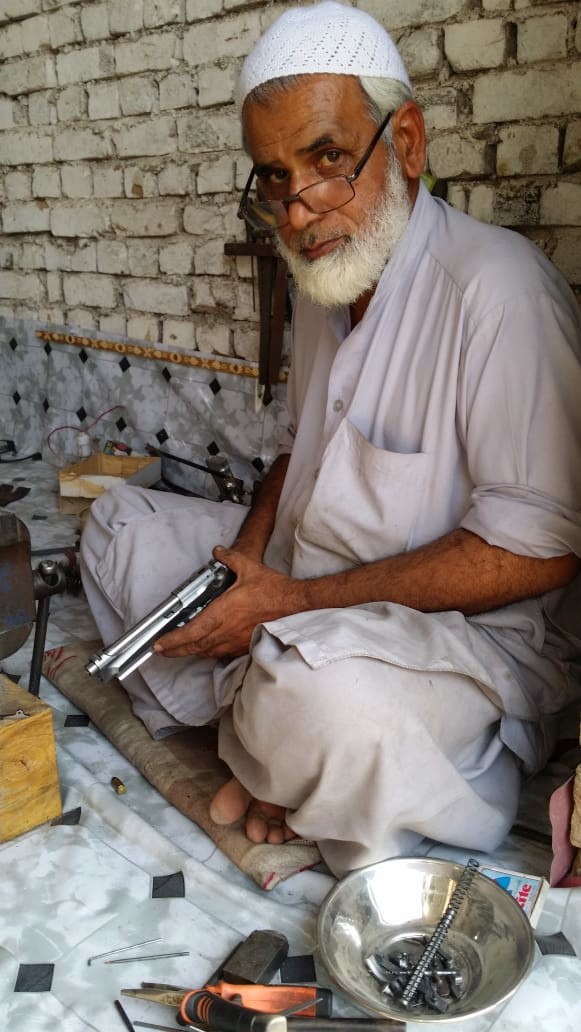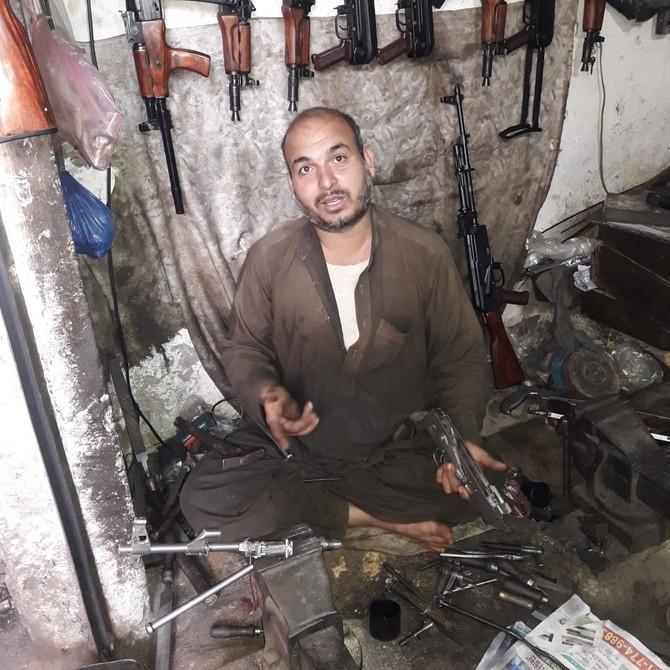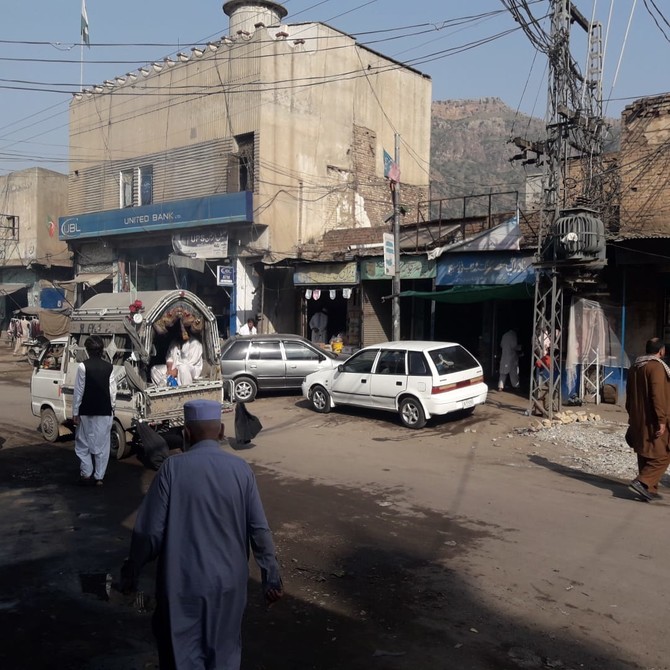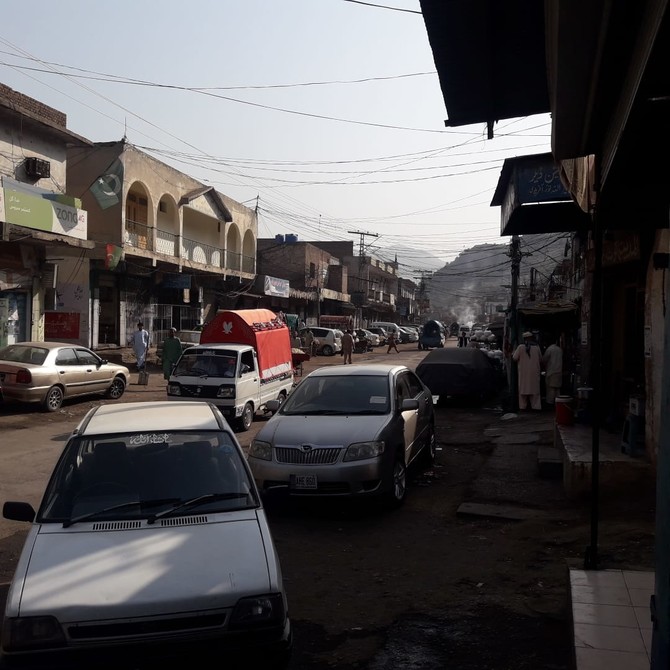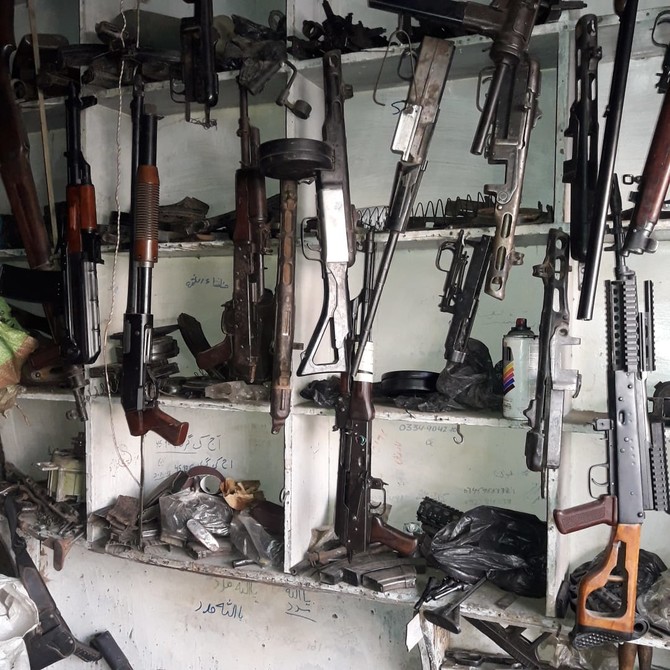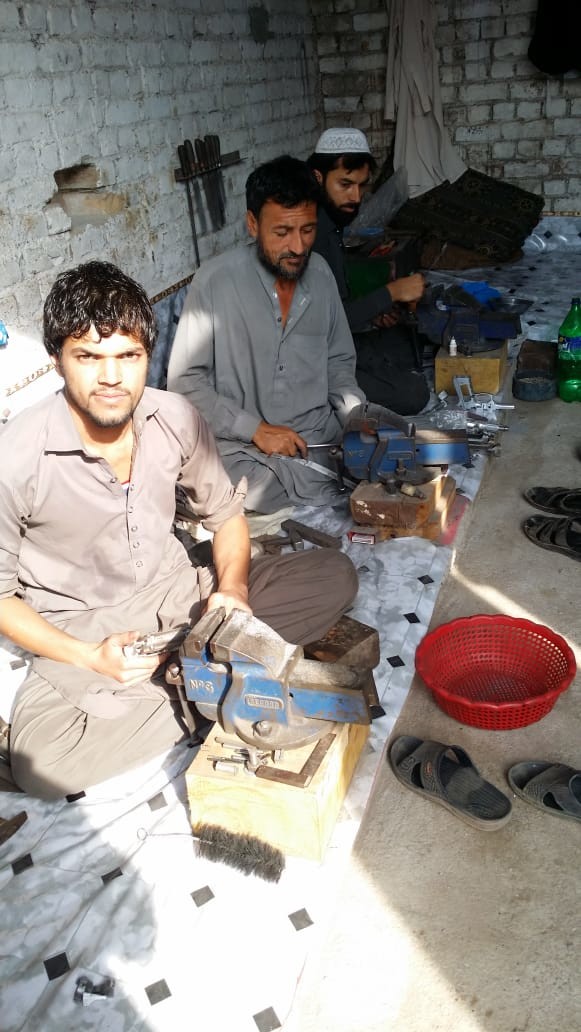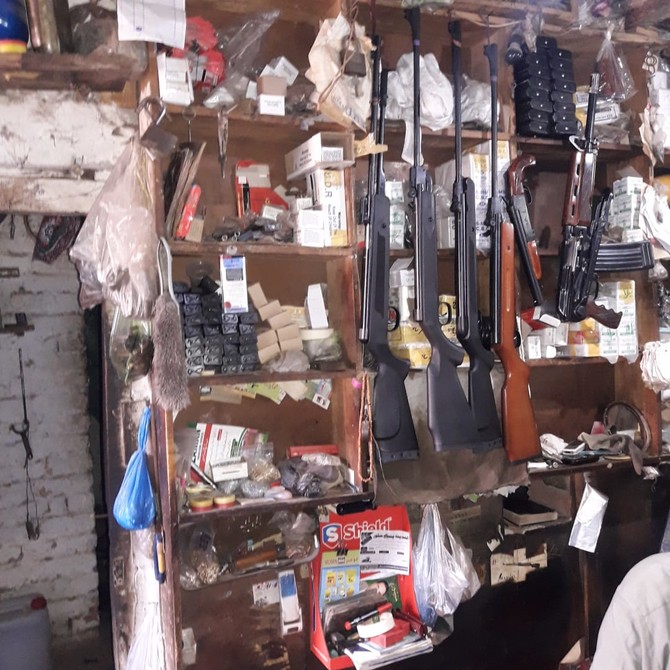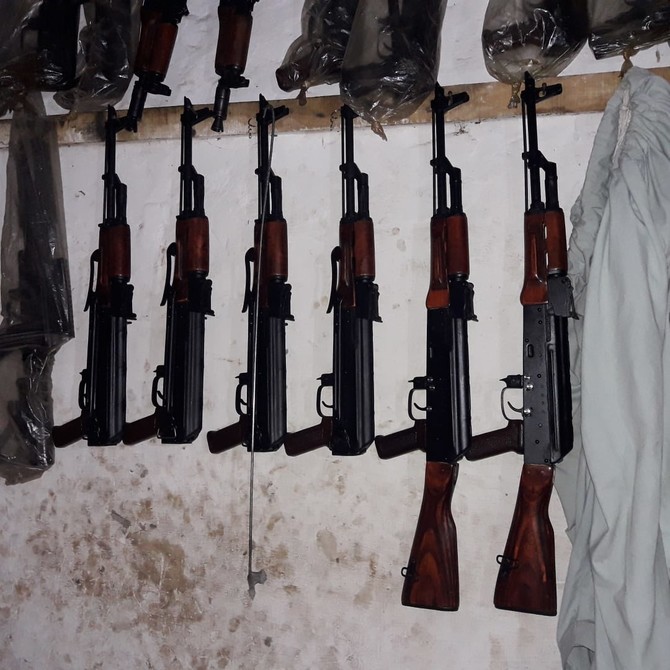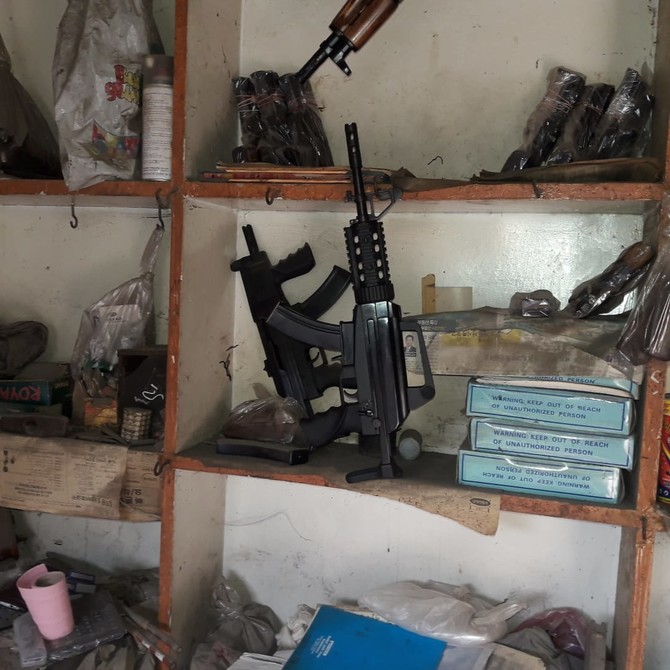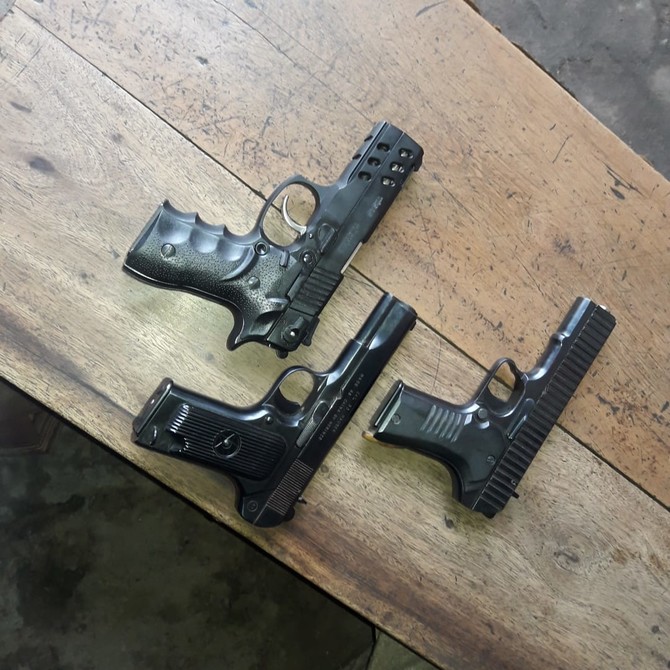DARA ADAM KHEL: It’s all guns and no roses for the shop owners of the weapons market that lines the bazaar in the dusty hamlet of Dara Adam Khel.
Inhabited by the Afridi tribe, the market has become the core identity of Dara Adam Khel — an area located between Kohat and Peshawar to the south of the Khyber Pakhtunkhwa province.
On any given day, it is packed with traders and merchants who have gained recognition for the quality and range of their guns and ammunition, with a number of tribesmen starting their businesses from scratch and soldiering on to become millionaires.
During an extensive range of interviews, where they spoke exclusively to Arab News, a majority shied away from taking credit for their craft, reasoning that they were only paying homage to skills passed on by their ancestors by taking the business forward.
Dating back to the pre-independence era of Pakistan, ancestors of these tribesmen — during their armed expedition in large swathes of Asia — learned the skills, passing it on to the future generations who developed it into a full-fledged arms industry in the Khyber tribal region.
Today, 40,000 to 50,000 residents of the area – with a total population of 110,000 — are directly associated with the industry, with every second owner saying that he inherited the business from his ancestors.
Quoting his great-grandfather, Kamran Afridi, a leading arms dealer from the area, said that members from the tribe used to form a Lashkar (armed resistance group) to fight the British imperial powers in parts of the Federally Administered Tribal Area, prior to 1947.
“There were times when tribal elders sent armed expeditions to parts of the sub-continent while the British forces used to come here to invade. Those types of armed clashes led them to learn ordnance and weapon-making skills, primarily from the Britishers. Then, our forefathers started replicating those skills when they would return from missions abroad,” Kamran said.
He added that while initially, it was a very tedious and slow-moving process to repair and manufacture small guns at their residential quarters or hujras; in time, his predecessors learned to develop their skills and eventually set up shops, hiring experienced and untrained laborers.
Later in the 50s, a few gunsmiths arrived from Punjab who were technically-trained in the craft and demonstrated comparatively-advanced methods of repairing and polishing second-hand weapons.
“Currently, according to my assessment, 6,000- 7,000 skilled laborers such as gunsmiths and professional manufacturers with technical expertise are involved in the arms hardware and ammunition-making process,” Kamran said, adding that, today, craftsmen from the market boast an incomparable expertise by being adept at assembling any type of weapon, on demand, with the help of a mere sketch.
The most popular items on sale include the 9-MM, 30-Bore guns, Repeaters, Kalashnikov and M-16 rifles. However, the industry prefers to manufacture non-prohibited weapons specifically for license holders, he said.
And while all the weapons are locally made, some hardware parts — such as springs and other items – are either sourced from Afghanistan or imported from western countries. However, according to Kamran, the biggest problem faced by the industry today is a questionable power supply and the government’s lack of commitment to regularize the market.
“The authorities never extend support to develop the industry. Rather, the recent military operations against militants in parts of the Khyber tribal district have dealt a severe blow to the business because of restrictions on the movement of people,” he said, suggesting that the government should instead introduce innovative measures to develop the market in the larger interest of the country.
“The weapons market can help bolster foreign exchange if the government helps improve its quality by introducing standard materials,” he added.
He reminisces a time, back in 2007, when former dictator Pervez Musharraf had approved Rs 50 million in funds to establish the Pakistan Hunting and Sporting Association, which was primarily aimed at modernizing the Dara Adam Khel weapons industry. That initiative, however, fizzled out due to political wrangling and bureaucratic red tape.
Last week, the federal government hinted at the possibility of allocating nearly 150 acres of land for the construction of an industrial zone catering to the weapons market, in the Mattani area of Peshawar, located near Dara Adam Khel. If the plans see the light of day, it would take two years to set up the infrastructure in the area.
Kamran said that the government has yet to kickstart the implementation process, even as the arms industry continues to irk residents of the area who complain of potential buyers randomly firing guns in the area due to the absence of a designated testing zone; and the lack of a proper sewerage system to drain chemicals and other wastes from the industry.
He added that while it will be a step in the right direction to designate an area specifically for the weapons industry, the move would also have far-reaching and negative consequences on small businesses.
That, however, does not seem to be a cause for concern for several gunsmiths who said that while they were working as unskilled laborers earlier, they have now gone on to become tycoons in the field.
One such rags-to-riches story is that of Muzaffar Khan Afridi who recalls a time in 1993 when he was working as a daily-wage gunsmith at arms and ammunition depot in Dara Adam Khel. “Today I have 30 gunsmiths working at my two ammunition stores,” he said.
Citing a lack of choice in terms of earning a livelihood in this impoverished part of the country, several said they had no other skills to teach their children and would be at the receiving end of the deal if small businesses were moved to the proposed industrial zone. “I have 17 members in my family and my business is the sole source of income,” Muzaffar said.
Samiullah Afridi, another weapons and ammunition dealer, thanked his great-grandfather for starting the family business from a hujra, which was eventually expanded to four stores in the market today. “According to a ballpark estimate, Dara Adam Khel has around 2,000- 3,000 arms depot and shops,” he added.
Throwing light on the intricacies involved in the arms-making process, Samiullah said that the metal and steel being used in the manufacturing of the weapons is recycled to improve its quality, standard and resistance power.
It’s a tedious process and involves days of hard work which begins by molding rigid steel — by tampering and designing it — to absorb massive and repeated shocks. The steel used by gun manufacturers in the US has an aluminum grading of 70-75, while the material used in Dara Adam Khel is for smaller guns and ranges between 40 to 45.
Highlighting the economic situation of the country, Samiullah said that while there continues to be a lack of employment opportunities across Pakistan, the weapons industry thrived dramatically due to an influx of educated youth who set up their own businesses in the market.
With the arrival of a more-informed generation of gun manufacturers who introduced innovative ideas, the industry was able to produce automatic rifles such as 9-MM, 30-Bore, 44, 223, 222, 32 and 12-Bore pistols, M-16, Kalakov, 7-MM, 8-MM, revolver, Makarov pistol and other brands of weapons.
He added that the government would no longer have to import small weapons if it allowed the import of small hardware items — such as steel and aluminum used in Brazil, Spain, USA, Turkey, and Russia – instead. This would help the industry produce locally-made weapons.
Secondly, the local weapons industry lacks a computerized system to check the standard, quality and resistance of steel. Despite all these deterrents, the most expensive gun manufactured locally is the M-16 also known as 223, which costs Rs 130,000.
Samiullah said that locally-made guns help small dealers – who operate from home — as all members of the family can assist each other, thereby saving their hard-earned money on rent, electricity and other amenities which otherwise they would have to spend toward the upkeep of a shop.
“We can produce excellent weapons to compete with the global market if the government regularizes the industry and offers incentives such as an uninterrupted power supply and legal cover,” Samiullah said.
Kamran concurs, adding that weapons manufactured in Dara Adam Khel are of a superior quality and can be exported to foreign countries only “if the government earnestly focuses on helping develop the industry.”
Dara Adam Khel’s weapons industry guns for greatness
Dara Adam Khel’s weapons industry guns for greatness

- Relocating market would have an adverse impact on small businesses, owners say
- Thriving manufactory took decades to develop and put Pakistan on the world map
In Pakistan, ceasefire with India seen as military victory, fueling surge of nationalistic fervor

- Pakistan has trumpeted successes in the skies, claiming its pilots shot down five Indian fighter jets in aerial battles
- India has released satellite images showing serious damage to air strips and radar stations at Pakistani military bases
ISLAMABAD: Pakistani officials and the public on Monday celebrated a ceasefire with India as a victory in their latest military confrontation which had raised widespread concerns that the two nuclear powers could end up in all-out war before a sudden truce was called.
Tensions between India and Pakistan over an attack in Indian-administered Kashmir that New Delhi blamed on Islamabad escalated last Wednesday, with India striking multiple Pakistani cities with missiles. Islamabad said 31 civilians were killed while India insisted it had hit “terrorist” infrastructure.
This followed nearly four days of the two nations hitting each other with missiles, drones and artillery in which dozens were killed, until Saturday evening when US President Donald Trump announced a surprise ceasefire that has largely held, except for a few alleged violations in the disputed Kashmir regions on both sides.
Pakistan has said its pilots shot down five Indian fighter jets in aerial battles, including three advanced French-made Rafales. India has released new satellite images showing serious damage to air strips and radar stations at what Indian defense officials say are multiple Pakistani military bases crippled by massive Indian airstrikes. Pakistan itself admitted India had tried to hit three air bases, including one in Rawalpindi, where the military’s highly fortified headquarters are located.
In both nations, political and military leaders are spinning the latest conflict as a victory.
On Monday, Pakistani Premier Sharif announced that his country would annually observe May 10 as ‘Youm-e-Marka-e-Haq,’ which means the Day of the Battle of Truth, to celebrate the success of Pakistan’s retaliatory strikes against India.
“The professional capabilities of our brave forces have made us proud,” Sharif said in a statement. “Youm-e-Marka-e-Haq will be celebrated every year across the country with enthusiasm and spirit of national unity.”
Even before the announcement of the commemoration day, crowds have gathered daily in the streets of several Pakistani cities since the ceasefire to celebrate what Sharif described as “military history” achieved by “our brave army in a spectacular fashion.” Parades have also been held at a land border crossing to shower the military with petals.
During a visit to a hospital where soldiers and civilians wounded during the four-day standoff were recovering, Pakistani army chief, General Asim Munir, said Pakistan’s retaliatory strikes were a “defining chapter” in the country’s military history, lauding the army’s “resolute and unified response” and the “steadfast support of the Pakistani people.”
Pakistan’s parliament also passed a resolution on Monday commending the army for its “victory.”
“[The House] commends the valiant armed forces of Pakistan for their exemplary professionalism, vigilance and courage in defending the sovereignty of Pakistan in response to unprovoked Indian aggression with exceptional restraint and responsibility, and through a measured and befitting response,” the resolution said.
“This House congratulates the entire nation which rose above all differences and stood united behind its leadership across the political spectrum with one voice.”
“HISTORY OF CONFLICT“
In India, premier Narendra Modi said New Delhi had only “paused” its military action and would “retaliate on its own terms” if there is any future militant attack on the country.
At a press briefing on Sunday, Indian military spokespeople offered more details on the offensive against Pakistan and claimed it was Pakistan that had first requested a ceasefire.
India said five of its soldiers were killed by Pakistani firing over the border and claimed Pakistan lost about 40 soldiers in firing along the line of control. It also claimed to have killed 100 terrorists living over the border in Pakistan. The numbers could not be verified.
It also claimed to have “downed a few Pakistani planes,” though it did not elaborate further. Asked about claims made by Pakistan, and backed up by expert analysis of debris, that Pakistani missiles had downed at least three Indian military jets during the offensive on Wednesday, including multimillion-dollar Rafale jets, India said, “losses are a part of combat” and that all its pilots had returned home.
The hostilities between the nuclear-armed rivals began after a deadly attack on tourists in Kashmir that killed 26 tourists last month. India accused Pakistan of backing the militants, a charge Islamabad denied.
Here is a look at multiple conflicts between the two countries since 1947:
1947 — Months after British India is partitioned into a predominantly Hindu India and a Muslim-majority Pakistan, the two young nations fight their first war over control of Muslim-majority Kashmir, then a kingdom ruled by a Hindu monarch. The war killed thousands before ending in 1948.
1949 — A UN-brokered ceasefire line leaves Kashmir divided between India and Pakistan, with the promise of a UN-sponsored vote that would enable the region’s people to decide whether to be part of Pakistan or India. That vote has never been held.
1965 — The rivals fight their second war over Kashmir. Thousands are killed in inconclusive fighting before a ceasefire is brokered by the Soviet Union and the United States. Negotiations in Tashkent ran until January 1966, ending in both sides giving back territories they seized during the war and withdrawing their armies.
1971 — India intervenes in a war over the independence of East Pakistan, which ends with the territory breaking away as the new country of Bangladesh. An estimated 3 million people are killed in the conflict.
1972 — India and Pakistan sign a peace accord, renaming the ceasefire line in Kashmir as the Line of Control. Both sides deploy more troops along the frontier, turning it into a heavily fortified stretch of military outposts.
1989 — Kashmiri dissidents launch a bloody rebellion against Indian rule. Indian troops respond with brutal measures, intensifying diplomatic and military skirmishes between New Delhi and Islamabad. India says Pakistan supports the insurgency, which it denies.
1999 — Pakistani soldiers and Kashmiri fighters seize several Himalayan peaks on the Indian side. India responds with aerial bombardments and artillery. At least 1,000 combatants are killed over 10 weeks, and a worried world fears the fighting could escalate to nuclear conflict. The US eventually steps in to mediate, ending the fighting.
2016 — Militants sneak into an army base in Indian-controlled Kashmir, killing at least 18 soldiers. India responds by sending special forces inside Pakistani-held territory, later claiming to have killed multiple suspected rebels in “surgical strikes.” Pakistan denies that the strikes took place, but it leads to days of major border skirmishes. Combatants and civilians on both sides are killed.
2019 — The two sides again come close to war after a Kashmiri insurgent rams an explosive-laden car into a bus carrying Indian soldiers, killing 40. India carries out airstrikes in Pakistani territory and claims to have struck a militant training facility. Pakistan later shoots down an Indian warplane and captures a pilot. He is later released, de-escalating tensions.
2025 — Militants attack Indian tourists in the region’s resort town of Pahalgam and kill 26 men, most of them Hindus. India blames Pakistan, which denies it. India vows revenge on the attackers as tensions rise to their highest point since 2019.
Both countries cancel visas for each other’s citizens, recall diplomats, shut their only land border crossing and close their airspaces to each other. New Delhi also suspends a crucial water-sharing treaty.
Days later, India strikes what it calls nine “terror” hideouts across Pakistan and Azad Kashmir with precision missiles. Islamabad retaliates and fires missiles and swarms of drones across multiple northern and western Indian cities, targeting military installations and air bases. India then targets Pakistan’s multiple air bases, radar systems and military installations. As the situation intensifies, the US holds talks with leadership of the two countries, and President Donald Trump announces a ceasefire has been reached.
— With inputs from AP
Pakistan finance minister says conflict with India won’t have large fiscal impact

- On Monday, US President Donald Trump said the US is ready to help India and Pakistan after a ceasefire agreement
- Pakistan faces a 29 percent tariff on exports to the US due to a $3 billion trade surplus, currently under a 90-day pause
KARACHI/ISLAMABAD: The recent military escalation with arch-rival India won’t have a large fiscal impact on Pakistan and can be managed within the current fiscal space, with no need for a new economic assessment, Pakistan’s Finance Minister said in an interview with Reuters on Monday.
Trade talks with the United States – which had played a key role mediating a ceasefire between the two countries – would likely have progress in “short order” and that Pakistan could import more high-quality cotton, more soy beans and was also exploring other asset classes, including hydrocarbons, Finance Minister Muhammad Aurangzeb said in the online interview.
On Monday, US President Donald Trump said the US is ready to help India and Pakistan after a ceasefire agreement, claiming trade was a big reason they “stopped fighting.”
Pakistan faces a 29 percent tariff on exports to the US due to an approximate $3 billion trade surplus, but this is currently under a 90-day pause announced in April.
The International Monetary Fund (IMF) on Friday approved a $1 billion loan disbursement to Pakistan as part of a larger $7 billion bailout agreement.
Aurangzeb said Islamabad would receive the tranche disbursement on Tuesday.
The IMF executive board also approved a fresh $1.4 billion loan to Pakistan under its climate resilience facility.
The federal budget for the next fiscal year, starting July, will be finalized within the next three to four weeks, with scheduled budget talks with the IMF to take place from May 14-23, he said.
Regarding the India-Pakistan conflict, Aurangzeb described it as a “short duration escalation” with minimal fiscal impact, stating it can be “accommodated within the fiscal space which is available to the government of Pakistan.”
When questioned about potential increased military spending in the upcoming budget, Aurangzeb deferred comment, saying it was premature to discuss specific plans. However, he said: “Whatever we need to do in terms of ensuring that our defense requirements are met will be met.”
Aurangzeb said he expects the Indus Water Treaty, which India unilaterally suspended, to be reinstated and rolled back to where it was.
He said there is not going to be any immediate impact from India’s suspension and Pakistan does not “even want to consider any scenario which does not take into account the reinstatement of this treaty.”
Tensions between India and Pakistan began mounting after the April 22 attack in Indian-administered Kashmir on Hindu tourists that killed 26 people, sparking the worst clashes between the nuclear-armed neighbors in more than two decades.
On Saturday, a ceasefire in the Himalayan region was announced by Trump, following four days of fighting and diplomacy and pressure from Washington.
Army chief, PM to fund reconstruction of Pakistan mosque damaged by Indian strikes — minister

- India last week struck multiple Pakistani cities with missiles over an attack in the disputed Kashmir region
- Four missiles struck a mosque and an adjacent house in Muridke, killing three civilians and injuring two others
KARACHI: Prime Minister Shehbaz Sharif and Army Chief General Asim Munir will personally finance the reconstruction of a mosque damaged by an Indian missile strike in the Muridke city of Punjab’s Sheikhupura district, a Pakistani federal minister announced on Monday.
India last week struck multiple Pakistani cities with missiles over an attack in the disputed Kashmir region. The strikes drew a “precise, proportionate” response from Islamabad.
However, four Indian missiles hit a mosque and an adjacent house within a complex in Muridke that New Delhi said belonged to a militant group, an allegation Pakistan has denied.
On Monday, Food Minister Rana Tanveer Hussain, Punjab Chief Minister Maryam Nawaz, Gen Munir and other officials paid a visit to the Government Jamia Ummul Qura Mosque in the eastern Pakistani city.
“Announcing the government’s decision to reconstruct the mosque, he (Hussain) stated that the PM and the army chief have pledged to rebuild the mosque at their personal expense,” the Pakistani Ministry of National Food Security and Research said in a statement.
The Indian strikes had killed three Pakistani civilians and injured two others, according to Pakistani media.
During Monday’s visit, Pakistani officials met with the injured civilians and inquired about their well-being, according to the national food ministry. They announced top-tier medical care along with support for the families of the martyrs.
The visit came as director generals of military operations from India and Pakistan held talks, Reuters reported, following a US-brokered ceasefire that stopped four days of intense drone, missile and artillery fire.
Last week’s hostilities were triggered by a militant attack in Indian-administered Kashmir’s Pahalgam resort town that killed 26 tourists on April 22. New Delhi blamed Pakistan for the assault, Islamabad denied it.
Kashmir has remained a flashpoint between India and Pakistan since their independence in 1947, with both claiming the region in full but ruling it in part. Both countries have fought two of their three wars over the region.
Modi says India has only ‘paused’ military action against Pakistan

- India won’t “tolerate nuclear blackmailing” by Pakistan, would take stern action for any future militant attack, Modi says
- His comments were the first since Saturday’s understanding between India and Pakistan to stop all military actions
NEW DELHI: Indian Prime Minister Narendra Modi said on Monday India has only “paused its military action” against Pakistan and would “retaliate on its own terms” if there is any future militant attack on the country.
His comments were the first since Saturday’s understanding between India and Pakistan to stop all military actions on land, in the air and at the sea in a US-brokered ceasefire.
The escalating hostilities between the two nuclear-armed rivals after a deadly attack on tourists in Kashmir had threatened regional peace.
“We will be monitoring every step of Pakistan,” Modi said in an address to the nation, adding that India won’t “tolerate nuclear blackmailing” by Pakistan and would take stern action for any future terror attack.
“This is not an era of war, but this is not an era of terrorism either. There should be zero tolerance for terrorism,” Modi said.
The PM’s comments come from as Indian and Pakistani authorities both said Monday there was no firing reported overnight along the heavily militarized region between their countries, the first time in recent days the two nations were not shooting at each other.
“The night remained largely peaceful across Jammu and Kashmir, and other areas along the international border,” the Indian army said in a statement, adding that no incidents had been reported.
Senior military officials from India and Pakistan spoke via a hotline on Monday, the state-run Pakistan Television reported. It gave no details, but the two sides were to assess if the ceasefire was holding and how to ensure its implementation. There were fears it would not hold after they accused each other of violations just hours after it was announced.
Local government officials in Pakistan-administered Kashmir, called Azad Kashmir, reported no incidents of cross-border firing along the Line of Control and said that civilians displaced by recent skirmishes between Pakistani and Indian forces were returning to their homes.
Pakistan’s military spokesperson, Lt. Gen. Ahmad Sharif, said late Sunday that Pakistan remains committed to upholding the ceasefire and will not be the first to violate it.
Soon after the ceasefire announcement on Saturday, Pakistan reopened all of its airports and restored flight operations. India followed up Monday with reopening of all the 32 airports that were shut temporarily across northern and western regions due to the flare up in tensions.
“It’s informed that these airports are now available for civil aircraft operations with immediate effect,” the Airports Authority of India said in a statement.
The militaries of the two countries have been engaged in one of their most serious confrontations in decades since last Wednesday, when India struck targets inside Pakistan it said were affiliated with militants responsible for the massacre of 26 tourists in Indian-controlled Kashmir. The tourists, mostly Indian Hindu men, were brutally killed in front of their families in the meadow town of Pahalgam last month.
India accused Pakistan of backing the militants who carried out the massacre, a charge Islamabad denied. The incident first led to a spat of tit-for-tat diplomatic measures by both the nations, sending their bilateral ties to a near historic low.
The two expelled each other’s diplomats, shut their airspace, land borders, and suspended a crucial water treaty.
After Wednesday’s strikes in Pakistan, both sides exchanged heavy fires along their de facto border in the restive Kashmir region followed by missile and drone strikes into each other’s territories, mainly targeting military installations and air bases. Dozens of civilians were killed on both the sides in heavy shelling, the two countries said.
The Indian military on Sunday for the first time claimed its strikes into Azad Kashmir and Pakistan last week killed more than 100 militants, including prominent leaders.
Lt. Gen. Rajiv Ghai, the director general of India’s military operations, said India’s armed forces struck nine militant infrastructure and training facilities, including sites of the Lashkar-e-Taiba group that India blames for carrying out major militant strikes in India and the disputed region of Kashmir.
Ghai said at least 35 to 40 Pakistani soldiers were killed in clashes along the Line of Control, the de facto border that divides the disputed Kashmir region between India and Pakistan. Five Indian soldiers were also killed, he said.
Pakistan’s Information Minister Attaullah Tarar on Thursday said his country’s armed forces had killed 40 to 50 Indian soldiers along the Line of Control. Pakistani military also claimed to have shot down five Indian fighter jets and inflected heavy losses on Indian military installations by targeting 26 locations in India.
The Associated Press couldn’t independently verify the claims made by India and Pakistan.
Air Chief Marshal AK Bharti, the director general India’s air operations told a news conference on Monday that despite “minor damage (s) incurred, all our military bases and air defense systems continue to remain fully operational, and ready to undertake any further missions, should the need so arise.”
Bharti reiterated that New Delhi’s fight was “with terrorists, and not with Pakistan military or its civilians.”
Trump says used US trade ties to persuade India, Pakistan on ceasefire

- India and Pakistan last week used fighter jets, drones, missiles and artillery to attack each other in the worst fighting between them in decades
- The two countries reached an understanding to stop all military actions on land, in the air and at the sea on Saturday in a US-brokered ceasefire
ISLAMABAD: President Donald Trump said on Monday he had used United States (US) trade ties with India and Pakistan to persuade the nuclear-armed nations to back off from further military confrontation and agree to a ceasefire.
India and Pakistan reached an understanding to stop all military actions on land, in the air and at the sea on Saturday in a US-brokered ceasefire to cease escalating hostilities that had spiraled alarmingly, threatening regional peace.
The two sides used fighter jets, drones, missiles and artillery to attack each other in the worst fighting between them since the 1999 Kargil war, leaving around 70 people dead on both sides of the border.
Speaking at an event at the White House, Trump said the countries ended hostilities for a lot of reasons “but trade is a big one,” adding that Washington was already negotiating a trade deal with India and would soon start negotiating with Pakistan.
“On Saturday, my administration helped broker a full and immediate ceasefire, I think a permanent one, between India and Pakistan, ending a dangerous conflict of two nations with lots of nuclear weapons. They were going at it hard and heavy, and it was seemingly not going to stop,” he said.
“I said, ‘Come on, we are going to do a lot of trade with you guys. Let’s stop it. Let’s stop it. If you stop it, we will do trade, if you don’t stop, we are not going to do any trade.’ People have never really used trade the way I used it.”
While Trump thought his administration had brokered a permanent ceasefire between India and Pakistan, Indian Prime Minister Narendra Modi said in a Monday evening speech India had only “paused” military action against Pakistan.
Pakistan will have to get rid of its “terrorist infrastructure” if it wants to be “saved,” Modi said in his first comments since the ceasefire.
“I will tell the global community also, if we talk to Pakistan, it will be about terrorism only...it will be about Pakistan-occupied Kashmir,” Modi said, referring to Azad Kashmir.
Pakistan and India have a history of bitter relations and both countries have fought three wars, two of them over the disputed region of Kashmir. Last week’s military conflict between them was also triggered by a militant attack in Indian-administered Kashmir that killed 26 tourists on April 22.
India struck multiple Pakistani cities on Wednesday, blaming the April 22 attack on Pakistan. Islamabad denied any complicity in the assault and reciprocated with similar strikes against Indian military targets.
Modi’s comments came a day after Pakistan said its response to Indian strikes was a “great example” of the coming together of all elements of Pakistan’s national power, warning of a similar response to any future attempts to challenge the country’s sovereignty and integrity.
“No one should have any doubt that whenever our sovereignty would be threatened and territorial integrity violated, the response would be comprehensive, retributive and decisive,” Pakistani military spokesman Lt Gen Ahmed Sharif Chaudhry said at a presser.
On Sunday, Trump also said he would try to work with both India and Pakistan to see if they can resolve their dispute over Kashmir.
“I will work with you both to see if, after a ‘thousand years,’ a solution can be arrived at concerning Kashmir,” Trump wrote on his social media platform, Truth Social, referring to India and Pakistan.
India has for years insisted Kashmir is a bilateral issue and not allowed any third-party mediation.


